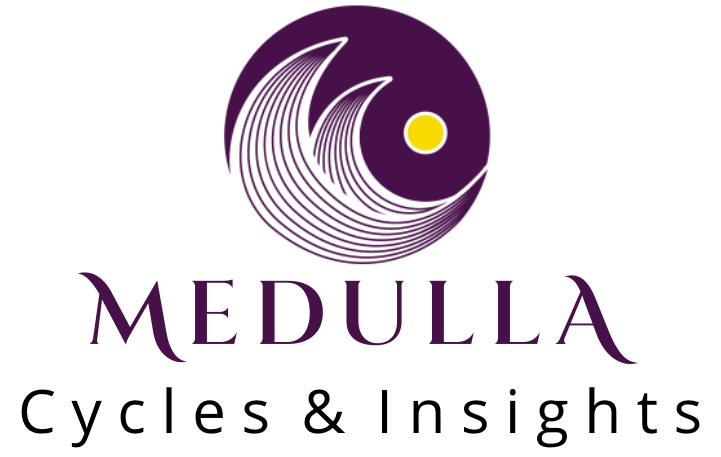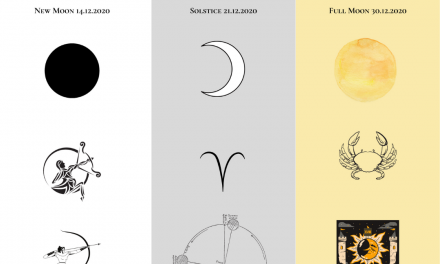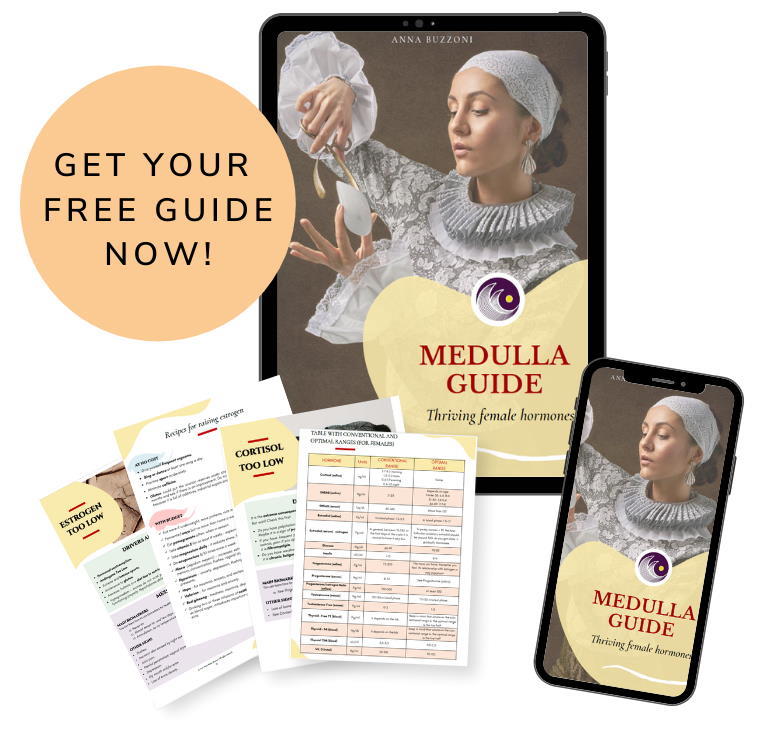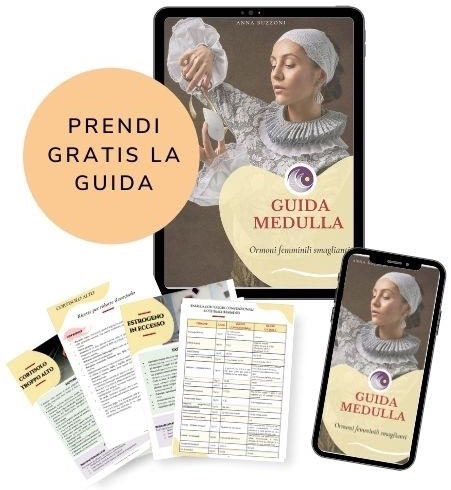What is premenstrual syndrome
Premenstrual syndrome (PMS) is usually defined as a psychological issue (mood disorders) with physical, cognitive and behavioral symptoms. Many authoritative health websites, like the Mayo Clinic, list it as a known disorder, while, in fact, the issue is unclear, as I will explain. The reasons why PMS may not be considered a disorder are very well explained by Dr. Robyn Stein DeLuca in her Ted Talk “The good news about PMS” – please watch it now in order to follow best.
Click on the button to load the content from www.ted.com.
On the other hand, Premenstrual Dysphoric Disorder (PMDD) is a much better defined issue and it is listed in the Diagnostic and Statistical Manual of Mental Disorders.
This article, however, will deal with PMS only, and will try to shed a light on the premenstrual phase, better called, the luteal phase of the menstrual cycle. I will share some insights derived from Studio Medulla’s approach: comparative studies of cyclicity.
COMPARATIVE RESEARCH ON CYCLES
Comparative studies on cycles is an emerging field with the potential to shift the paradigm and the way we understand reality and life. It compares biological cycles (eg breath, circadian clock, digestion, heart, season, brain waves, seasons, plant sap, etc.) as well as cycles in culture (archetypes, design thinking theory, linguistics, anthropology, economics, etc.), and has two main goals: to understand the common underlying matrix, or blueprint and to apply these findings to several disciplines. Applications are potentially relevant, besides individuals, to clinical physicians and nurses, psychologists, neuroscientists, coaches, economists, sociologists, urban planners, and so on and so forth. It is a paradigm shift, and an article is not enough to unpack all its ramifications, so this is just a peek.
Any biological cycle has a common matrix of four phases – two pauses and two dynamic phases:
- a nadir (think of empty lungs – which is how we were born – empty stomach, night time, dark moon, plant sap concentrated in the roots, winter, healing phase of brain waves in the attention-rest brain cycle, etc.)
- an extrovert dynamic phase (breathe-in, ingestion, morning, crescent moon, plant sap rising, spring, rising brain wave, etc.)
- a zenith (full lungs and stomach, afternoon, full moon, plant sap concentrated in the top, summer, peak attention, etc.)
- an introvert dynamic phase (breathe-out, transformation and elimination of waste, evening, waning moon, plant sap descending to the roots, autumn, stress response of the brain, etc.).
The menstrual cycle also presents the same matrix.
- A nadir, where both estrogen and progesterone are at minimum terms, where there is apparent death and reset of the uterus (now think of who also has empty lungs, yes, dead people, who, by the way, look very much alike alive people when asleep, aka at night; the moon that is there but cannot be seen; the sap that is hidden underground, the apparent death of nature in winter, etc.)
- an extrovert phase, where estrogen (linguistics says it all) wakes up the dormant uterus which starts growing its internal lining outward (from its perspective); stimulates attention, rational (linear) thinking focused on objectives, cognition (like the morning hours) and social extroversion; increases pain threshold; speed; faster absorption of sugar; etc.
- a zenith, when estrogen peaks and the egg is released, there is a peak of testosterone, serotonin and dopamine, giving people an extra boost in assertiveness, confidence, libido, but also capacity for deep listening, empathy, coordination and positive outlook.
- an introvert phase, where progesterone dominates. More below.
Progesterone has several tasks and this list is non-exhaustive: it softens the endometrial lining to allow nesting; relaxes muscles and nerves; stimulates the right hemisphere; increases temperature and metabolism; increases blood pressure in the uterus; increases sleep quality (spindles), need for sleep and slowing down: and creativity disengaged by the objective, in other words, art pour l’art, or creativity as a process.
When we are relaxed, when we slow down, we are more sensitive.
That is why we hold our breath when we are in pain: breathing out, which relaxes our muscles, makes us more sensitive to pain. When we were kids and we lost a dare, if the punishment was a punch on your shoulder, all you could do to limit painful feelings was…to contract your muscles! Mindfulness and meditation techniques teach us that, although it is the whole cycle (of breath) that matters, it is when breathing out that we can fully relax, create space, and access the inner body with its bountiful wisdom.
THE PREROGRATIVES OF PHASE FOUR
Phase 4 also takes stock of what has happened so far in the cycle. Think of autumn, the harvest season since before agriculture: plants are releasing seeds and earth is receiving them (just like the endometrium is now ready for nesting), and seeds will be only as good as earlier seasons were. If winter, spring and summer were less than ok, seeds will carry this information onto the next cycle. Sunsets are charged with melancholy, not sunrises, which are inspiring and stimulating. It is in the evening that we take stock of the day, feel sleepy, and less tolerant, because we are bloody tired, are we not?
In Design Thinking Theory, if phase 3 is the full manifestation of the prototype (like ovulation is to the menstrual cycle, but also summer fruits, peak attention, etc.), phase 4 is called “testing” or “feedback phase”. It is called “stress response” in the attention cycle of the brain. Every phase 4 is a test of what has come before, a selection, a shedding of what needs to “die” and what needs to be carried forward. This is also true for fever, which manifests itself in all its magnitude in the evening (phase 4 of the circadian clock).
In order to unleash the full potential of discernment, nature makes us more sensitive, by way of making us more relaxed, and before starting another cycle, nature wants us to “harvest” lessons learnt.
We do not expect people to display the same cognitive abilities in the evening, after a full day of life and work. However, we do expect them to be more relaxed, and prone to intimate sharing than in the morning. It is not an accident that fairy tales (which carry life lessons and archetypal truths) were shared in the evening. We do not expect the brain to keep up its peak attention indefinitely. We now know that sleep is the single most important ingredient for regeneration and health. Phase 4 is a great opportunity: the opportunity to comprehend, to become wiser. But we need to remove obstacles for it to flourish and gift us with its properties. The premenstrual phase is a great opportunity to slow down and make space for all the things that we were too busy to integrate, too focused to comprehend.
We expect, however, that people with a menstrual cycle live a linear life throughout the month. These people are, in fact, cyclical and should be aware of their ciclicality in order to flourish and thrive.
We need to renegotiate space-time in our homes, cities and business.
Mind you, everybody and everything is cyclical; the menstrual cycle is just another superficial manifestation of the underlying matrix, or, as I call it, the thriving blueprint of life. We can call it rhythm, if you prefer.
By becoming more sensitive, by slowing down and holding space, we can access inner wisdom and integrate all the loose pieces that we have collected, but not processed, along the way.
What is more, unresolved issues could also resurface, and obstacles hindering our efforts could be revealed. Like a low tide, progesterone allows them to come to the surface. For example, a poor diet will cause more problems during the premenstrual phase, and toxic relationships will cause more anxiety and frustration.
The cycle is the revealing mechanism, not the cause of dis-ease.
There is one important aspect that I have not addressed: intuition. Intuition, or knowledge that is not mediated by reasoning, is a poorly understood skill, and many would even argue it does not exist. Luckily, neuroscience is making progress in this regard and we now know that intuition not only exists, but is actually a cornerstone of good business decisions, innovation and creativity. Intuition is not mediated by the brain, it resides in the mind perhaps, but the intuitive mind, which, in turn, resides in every cell of our body. Intuition is in the body. As the body takes over during phase 4, via increased sensitivity, we can assume that this is the best phase to access intuition. Intuition is the gate for comprehending, rather than understanding, how to take care of our overall health, and it is more accessible during the premenstrual phase. Do not forget that the menstrual cycle is the fifth vital sign!
In order to develop stronger intuition, one method that works well, in both scientific and anecdotal evidence, is body literacy. Body literacy is the language and knowledge that we need in order to decode symptoms (good, bad, neutral) and transform them in insight and self-care. Body literacy requires first and foremost embodiment, not books. It requires to be present without judgement in the body. Those practicing meditation and mindfulness will probably know – intuitively – what I mean.
People who are severed from their body wisdom and intuitive muscle could be at higher risk of having problematic premenstrual phases: the messages that their body wisdom is trying to deliver will not be understood and are likely to create confusion, frustration and unexplained anxiety.
As Prof. Jane M. Ussher eloquently said in the second episode of Clue podcast “Hormonal”, the majority of her patients points their finger at PMS, when, in fact, what gets on their nerves are irresponsible or unjust (in their eyes) behavior of other people and family members. Therefore PMS not only has psychological and physiological roots, but also cultural and gender explanations.
To conclude, the premenstrual phase is the revealing phase of a cycle. The problems that some of us face during that phase have dignity, a message and a language, which can be learnt, decoded and translated into insight and (self)care.
Comparative studies of cycles deserves attention and resources, as this new field of study can greatly inform, and be a paradigm shift, not only for women’s health. Its ramifications are far-reaching and deeply meaningful, including for economic models and the environmental crisis.
Cyclicity is how nature, therefore humans, create value and meaning in entropy.
If you are a little confused, I hear you! Comparative studies on cycles are completely new but, I believe, will change our way of measuring and understanding reality (did you know that this is exactly what the word menstruation means? The ability to measure reality?).
It is not something that can be unpacked in an article though. We can dig deeper on 16.11.2019 in Berlin with Medulla’s advanced seminar on Pre/menstrual Dis/ease. More info here. I hope you will join the me.
Heartfelt thanks to Ruby May who contributed reflections and feedback – in the spirit of phase 4 – that have improved this article. Any mistake is mine.
References:
Books:
Briden L., 2015, The period repair manual, Create Space Independent Publishing Platform
Ernout A., A. Meillet, 1932, Dictionnaire étymologique de la langue latine. Histoire des mots, Parigi, Klincksieck
Frank P., et al., 2011, Natürlich und sicher, Colonia, Malteser Arbeitsgruppe NFP
Harari, Y. N., 2014, Sapiens, Penguin
Hyman M. 2009, The Ultramind solution, New York, Scribner
Joosen V., 2008, Critical and Creative Perspectives on Fairy Tales, Wayne State University Press
Kahneman, D, 2011, Thinking, fast and slow, Penguin
Kippley J., S. Kippley, 2003, The art of natural family planning, Cincinnati, CCL
Gallo B., 2003, Neuroscienze e apprendimento, Napoli, Ellissi
Gimbutas M., 1989, The language of the goddess, New York, Thames and Hudson
Gottfried S. 2014, The hormone cure, New York, Scribner
McGilchrist I., 2009, The Master and his emissary, Yale University Press
Northrup C., 2010, Women’s body, women’s wisdom, New York, Bentam Books
Pinkola Estés C., 2007, Donne che corrono con i lupi, Milano, Frassinelli
Pope A., 2014, The wild genie, Bedfordshire, Authors OnLine
Restrepo J., 2005, La luna, el sol nocturno en los trópicos y su influencia en agricultura, Colombia, Brasile, Messico, Fundación Juquira Candirú
Rovelli, C, 2017, Reality is not what it seems, Penguin
Schiebler TH et al., 1999, Anatomie, Berlino, Springer
Soojung-Kim Pang, A., 2015, REST Why You Get More Done When You Work Less, Basic Books
Weschler, T, 2015, Taking charge of your fertility 20th Anniversary Edition, New York, Harper Collins
Walker, M, 2018, Why we sleep, Penguin
Scientific papers:
Hampson E., 1990, Psychoneuroendocrinology, Estrogen-related variations in human spatial and articulatory-motor skills, Vol. 15 , No. 2 , 97 – 111
Miller G. et al. 2007, Evolution and Human Behavior, Ovulatory cycle effects on tip earnings by lap dancers: economic evidence for human estrus?, Vol. 28 , No. 6 , 375 – 381
Monteleone P, Beinat L, Tanzillo C, Maj M, Kemali D, Effects of Phosphatidylserine on the Neuroendocrine Response to Physical Stress in Humans. Neuroendocrinology 1990;52:243-248
Skovlund CW, Mørch LS, Kessing LV, Lidegaard Ø., 2016, JAMA Psychiatry. Association of Hormonal Contraception With Depression, Vol. 73, No. 11, 1154-1162
Prior JC, 2014, Journal of Restorative Medicine, Progesterone Within Ovulatory Menstrual Cycles Needed for Cardiovascular Protection: An Evidence-Based Hypothesis, Vol. 3, 85-103, accessibile anche online http://www.cemcor.ubc.ca/sites/default/files/uploads/Prior%202014%20Progesterone…%20needed…%20CV%20protection…%20J%20Restor%20Med.pdf, ultimo accesso 17/12/2017
Tamres, L. K., Janicki, D., & Helgeson, V. S. (2002). Sex differences in coping behavior: A meta-analytic review and an examination of relative coping. Journal of Personality and Social Psychology Review, 6, 2-30. http://journals.sagepub.com/doi/abs/10.1207/S15327957PSPR0601_1 (ultimo accesso 26/03/2017)
Reay JL, Scholey AB et al, Panax ginseng (G115) improves aspects of working memory performance and subjective ratings of calmness in health young adults. Human Pharmacology 25 (6) (2010): 462-71
Li D. Et al., 2013, Epidemiologic Reviews, Negative Spinal Bone Mineral Density Changes and Subclinical Ovulatory Disturbances—Prospective Data in Healthy Premenopausal Women With Regular Menstrual Cycles, Vol. 36, No. 1, 137 – 147, Oxford University Press
Zenab A. et al, 2005, Behavioral and Cognitive Neuroscience Reviews, Effect of Estrogen-Serotonin Interactions on Mood and Cognition, Vol 4, Issue 1, pp. 43 – 58
Other sources:
https://www.menstrual-matters.com/blog/pms, ultimo accesso 10/10/2018
American College of Obstetricians and Gynaecologists, 2015, Menstruation in Girls and Adolescents: Using the Menstrual Cycle as a Vital Sign, ACOG, http://www.acog.org/Resources-And-Publications/Committee-Opinions/Committee-on-Adolescent-Health-Care/Menstruation-in-Girls-and-Adolescents-Using-the-Menstrual-Cycle-as-a-Vital-Sign, ultimo accesso 17/12/2016
DeNoon D., 2008, Pill Users Choose ‘Wrong’ Sex Partners, WEBMED, http://www.webmd.com/sex-relationships/news/20080812/bad-sex-pill, ultimo accesso 17/12/2016
https://www.blueletterbible.org/lang/lexicon/lexicon.cfm?t=kjv&strongs=g3933 , ultimo accesso 5/2/2017
http://www.etimo.it/?term=vergine ultimo accesso 5/2/2017
https://unaparolaalgiorno.it/significato/E/estro ultimo accesso 5/2/2017
http://www.dizionario-latino.com/dizionario-latino-italiano.php?lemma=GERO100 ultimo accesso 5/2/2017
http://www.etimo.it/?term=estro ultimo accesso 5/2/2017
http://www.drnorthrup.com/wisdom-of-menstrual-cycle/ , ultimo accesso 5/2/2017
Kwon D., 2014, Scientific American, Estrogen’s Role in Impulsive Behavior https://blogs.scientificamerican.com/mind-guest-blog/estrogen-s-role-in-impulsive-behavior/ ultimo accesso 24/5/2017
Yale University. “Estrogen Deprivation Leads To Death Of Dopamine Cells In The Brain.” ScienceDaily. ScienceDaily, 5 December 2000, www.sciencedaily.com/releases/2000/12/001204072446.htm, ultimo accesso 2/5/2017







